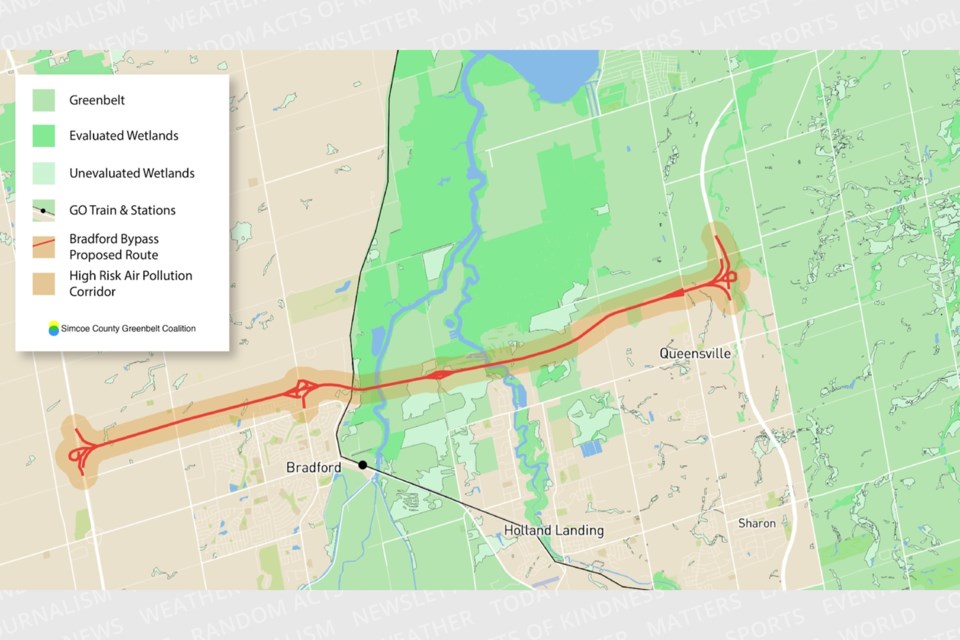NEWS RELEASE
RESCUE LAKE SIMCOE COALITION
*************************
Contractors for the Ministry of Transportation's Bradford Bypass plan to start building a bridge over York County Road 4 (old Highway 11), a half a concession north of the Town of Bradford as early as this fall. There is still no budget, design drawings, or even a finalized route for the proposed 16-kilometre highway that will span both east and west Holland Rivers, wetlands, forests and farm fields.
The impacts of the early works include the removal of 80 square metres of fish habitat. The Federal Department of Fisheries and Oceans (DFO) allowed them to proceed using a self-assessment process, via a letter of advice. Although the request clearly states that fish habitat will be permanently destroyed, DFO reminds them that the destruction of fish habitat is prohibited. When questioned by EcoJustice about the logic of this approval, DFO staff referred the question to their legal department, three months ago. No explanation has been provided to date.
The Stop the Bradford Bypass team has also discovered that not a single fisheries permit or Species at Risk Act permit has been declined in 22 years in either the Lake Simcoe or the Nottawasaga watershed.
Adam Weir, fisheries biologist, Ontario Federation of Anglers and Hunters says, “The construction of the Bradford Bypass will undoubtedly cause harm to fish habitat. We urge DFO to avoid, mitigate, or adequately compensate for these losses, as well as consider the cumulative effects of multiple stressors on provincially significant inland fisheries like Lake Simcoe.”
In the summer the Bradford Bypass consultants, AECOM, issued a draft Environmental Conditions Report (ECR). This report is intended to be a complete inventory of all significant environmental conditions along the highway route.
The problem, critics say, is that the final route has not yet been determined and a significant number of the studies needed to inform the Environmental Conditions Report have not been completed. Further, there is little that the province needs to do with the results of the studies since they have changed most relevant environmental legislation in Ontario and are “fast tracking” this particular project. The environmental conditions report is littered with “will consider” language, rather than “shall complete."
“Unfortunately, the news about this highway gets worse and worse. Nothing in the province’s fast-tracked Environmental Assessment process protects anything in the path of this highway,” says Bill Foster, Chair of Forbid Roads Over Green Spaces.
“For those who think this process is inadequate, we hear you,” says Rescue Lake Simcoe Coalition’s executive director Claire Malcolmson. “It is not ok to build new highways without proper oversight and sensible environmental planning. We continue to be astounded that the province is ignoring all of our concerns and those of the seven Lake Simcoe municipalities whose Councils passed resolutions for greater oversight and proper care for Lake Simcoe, and that the Federal government, despite its climate and natural areas priorities, is not stepping in and helping at all.”
Many concerned citizens have asked if this is the way Ontarians want to spend upwards of $1 billion dollars to trash the environment, while people face serious affordability concerns, a national healthcare crisis, and a global climate emergency. This question rests heavy on the hearts of the advocates for better planning.
The Rescue Lake Simcoe Coalition had 20,000 flyers delivered to residences in the Bradford, East Gwillimbury and Georgina area this week and launched a new petition on their website asking the Ministry of Transportation and the Department of Fisheries and Oceans Canada to stop work until the following is done:
- Assessment of harm to the Lake Simcoe watershed, demonstrating the ability to meet the Lake Simcoe Protection Plan’s science-based targets and objectives;
- Full archaeological assessment and full consultation with - and accommodation of - First Nations’ interests for putting a highway over an extremely significant historical / First Nations site, The Lower Landing;
- Proper permitting or denying permits to destroy the fish habitat they will destroy;
- Transparent reconsideration of Bypass routes to reduce environmental impacts on Lake Simcoe and allow regional governments to properly address local traffic issues;
- Demonstration that this highway will improve traffic movement.
*************************
